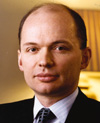Does new acquisition activity signal a revival of M&A? Some bankers believe so but others are cautious. Joanna Hickey reports.
A flurry of acquisition news has fuelled speculation that M&A activity is on the up again. As the debt and equity markets will receive a considerable fee income and volume boost from any M&A revival, bankers are hoping that the more bullish predictions will hold true.
After nearly three bleak years for global M&A, which has languished in the doldrums with volumes of just $1500bn in 2003 and $1400bn in 2002, against $3400bn and $3500bn in the peak years of 1999 and 2000 (according to information provider Dealogic), a growing number of bankers believe that the M&A revival has finally begun. Their new-found optimism springs from a series of high-profile deals that were announced in January.
Leading the pack is cable communications provider Comcast’s $66bn hostile bid for Walt Disney, which would create the largest media group. Then there is global healthcare company Sanofi Synthelabo’s $60bn hostile and, thus far, rejected bid for pharmaceutical company Aventis, which would create the world’s second largest pharmaceutical group. Close behind is the landmark $58bn JP Morgan/Bank One merger – one of the largest banking mergers ever after Citicorp and Travelers’ $70bn tie-up in 1998. Meanwhile, a bidding war is poised to erupt for AT&T Wireless following wireless company Cingular’s mooted $27bn offer and Danish brewer Carlsberg has offered E1.065bn for Germany’s Holsten-Brauerei.
Signs of change
Rising equity valuations, strong debt capital markets, the improving economy and corporates’ need to expand, enter new markets, derive synergies and cut costs through consolidation are all factors that suggest that the recent trickle could become a consistent stream. After nearly three years of investment retrenchment, companies have restructured, reduced debt and got their balance sheets in order by divesting non-core assets. They are now ready to starting buying again to enhance their core businesses.
Thus some bankers are highly optimistic about an M&A revival in 2004. “We are very positive about M&A this year. In the US, company earnings improved dramatically in 2003, back to the peak level in 2000. Corporates have cash once again and much of this will be spent on M&A. Companies need to make acquisitions to grow their business and become global,” says Paul Gibbs, global head of M&A research at JP Morgan.
Bullish attitudes
The more bullish bankers point out that the main factors required for M&A activity to flourish have reappeared, especially in the US. “The end of 2003 and the start of 2004 have been positive for M&A. In the US, all three drivers of M&A are now present: strong equity markets, availability of financing and company profit growth. CEOs are considering deals now that they would not have done even six months ago,” says Charles Alexander, co-head of corporate finance for M&A at Lehman Brothers.
Philip Yates, head of European corporate banking at Merrill Lynch, agrees that chief executives appear increasingly bullish. “Confidence levels among executive management teams have increased. They are ready both to revisit old consolidation propositions and to embrace new ones,” he says.
Caution remains
However, some bankers remain cautious about the likely revival of acquisition activity in 2004, citing several potential barriers. Nigel Turner, head of global corporate finance and global equities at ABN AMRO, says: “I am more optimistic about M&A than I was in 2002 or 2003. But there are two potential obstacles to any revival. The weakness of the dollar will deter many Americans from acquiring in the eurozone. And, following Enron and Parmalat, nervousness exists about the quality of public data.”
In addition, following the last boom, some bankers believe that M&A is not necessarily a good thing, given the possible dangers of overpaying and destroying value. The more upbeat banks reject this theory, however. “If you do not overpay – and I think companies are very aware of these dangers now – and if you execute the integration well, M&A is the best way to add products, achieve scale and globalise,” says Mr Gibbs.
Paul Gibbs: positive about M&A this year ‘The big deals tend to be all-stock, while half those in the $1bn-10bn category are financed by cash and debt’
Limited recovery
All bankers agree, though, that M&A will not return to the peak levels seen in 1999 and 2000. “We will see a recovery in M&A this year, in that it will exceed 2003’s levels. But there will not be a huge surge like [there was] in 1999-2000 for years. That surge was driven by the technology boom and for such a flood to happen again, we would need another major reason for investors to be excited,” says Mr Alexander.
Mr Turner agrees that the market is unlikely to see activity on a par with 1999 and 2000 in the foreseeable future, measured by number of transactions. “There was a financial illogicality to that level of M&A, as it was based on unrealistic presumptions of growth,” he says.
In terms of likely M&A hotspots, some bankers feel that European companies are currently more vulnerable to takeovers by their US rivals. US firms were quicker to cut costs in the downturn and are therefore recovering more quickly. On the flip side, however, although the US stock markets have rebounded more strongly, the weak dollar makes US firms more attractively priced to European and Asian companies.
Charles Alexander: M&A drivers present in US ‘Companies now have a choice between stock or debt financed deals’
Sector activity
As for sectors, following the tie up between JP Morgan and Bank One, further activity is expected in the US banking industry. After backing off from M&A in the past few years, there could also be some deals in Europe’s banking industry. “We expect further consolidation in the financial services sector,” says Mr Turner. “The US will lead the way but in Europe we should also see some intra-country banking transactions, probably first in Germany and Italy, followed by cross-border activity.”
The telecoms sector is emerging from exile and will be a focus of M&A activity this year. The post-restructuring NTL could move in on Telewest, while second tier European telecoms are expected to merge and, following the bid for AT&T Wireless, further acquisitions are anticipated in the US wireless sector.
Further pharmaceutical consolidation is expected. Sanofi could sweeten its hostile bid for Aventis, and there are rumours that Swiss drug giant Novartis could bid for Schering, the German pharmaceutical specialist. The steel sector is also tipped for M&A activity, due to disparities in manufacturing costs across different countries. And Asian manufacturers for European and US brand names in the electrical, sportswear and consumer goods sectors could move to acquire the companies they supply. Following 2003’s rash of retail sector public to private equity buy-outs, further retail tie-ups are possible, although this time the buyers will also be corporates.
Calling capital markets
The debt and equity capital markets will benefit from any M&A revival, due to the resulting boost to both fee income and volumes.
Given the dramatically improving equity markets, stock-for-stock deals are back on the menu. After two-and-a-half years of plummeting prices, the global equity markets have been on an upward trajectory since March last year, led by the US. From a closing low of 3287 in March 2003, the FTSE 100 stood at 4412 on February 2 this year (against its peak of 6930 in December 1999), while the S&P 500 stood at 1131 on February 2, up from its October 2002 low of 777 and against its March 2000 peak of 1572. Rising equity prices mean that potential suitors can once again offer up their own stock as part of a deal.
The debt capital markets are extremely liquid. “The capital markets are open to fund the increased levels of M&A activity expected for this year,” says Mr Yates.
Thus any M&A revival could be financed in either the equity or debt capital markets. “It is hard to generalise about the financing of M&A deals. But unlike one year ago, when the stock market would not have been an M&A financing option, companies now have a choice between stock or debt financed deals,” says Mr Alexander.
Historically, the largest deals have veered towards equity, while the smaller deals have more frequently been financed by cash. “The big deals tend to be all-stock, while half those in the $1bn-10bn category are financed by cash and debt. Most deals under $1bn tend to be cash financed. A company will not issue shares if it does not have to,” says Mr Gibbs.
Bond and debt support
Given the lessons of the recent past, the bond and loan markets will be called on to support the stronger cash-flow sectors. “There is much greater sophistication in the analysis of the cost of capital now,” says Mr Turner. “In very stable sectors and companies with positive cash flows, there will be a reliance on debt to finance acquisitions. But in less cash-flow predictable industries, stock will dominate the form of consideration. There is too much recent evidence of the dangers of acquiring high technology industries with debt.”
Yet debt bankers who are hoping for lucratively-priced acquisition financings may be disappointed. Given the extremely high liquidity in the bond markets and that investor demand outstrips deal supply in the loan market, with banks offering aggressive pricing to secure mandates, the usually considerable M&A pricing premiums will not necessarily apply.




